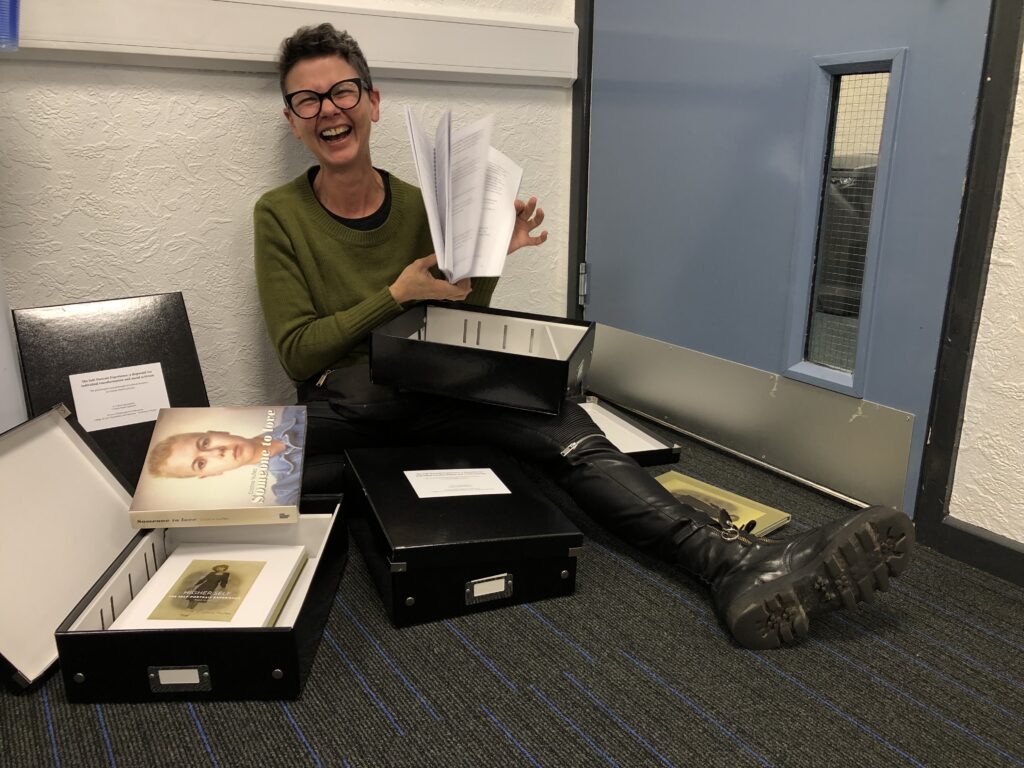
I am a self-taught artist, facilitator and researcher, but in 2017 I started my PhD by Publications at the College of Arts, University of Derby, UK, without having a degree, thanks to my independent research and my publications. In February 2020 I passed the viva exam with minor modifications and in November 2020 I got my PhD award. The title of my thesis, now available in my Academia profile, is:
The Self-Portrait Experience, a dispositif for individual and social transformation – The psychological and philosophical/political dynamics in Cristina Nuñez’s practice.
My thirty-year practice can be divided in two parts: the first (1988-1998) concerns my use of the self-portrait, unaware of its causes and dynamics, to respond to unconscious needs; the psychological inquiry starts in the second part (1998-2020), when observing that this artistic practice noticeably influenced my state of mind. The philosophical and political framework of the dispositif emerged in 2018 to interact with the psychological perspective, leading me to formulate the following research questions, which I have attempted to answer in my PhD by Publications:
- How can the photographic self-portrait be used as an artistic dispositif for individual transformation and as a political act?
- How do the power dynamics work in this dispositif and how do they foster self-knowledge and empowerment by allowing subversion?
- How can the self-portrait stimulate the unconscious creative process and provide critical outputs?
- How does emotional expression in the self-portrait influence the multiple perceptions of the images and what are its effects on participants’ self-image and wellbeing?
- How does SPEX contribute to contemporary practices such as the selfie, self-portraiture in contemporary art and therapeutic uses of photography?
I will briefly publish here some of the results of the quantitative and qualitative research.
Since 2009 my collaborations with academics on research projects have led me to gather evidence in my workshops, in order to investigate the transformative effects on participants. I have used questionnaires, open-ended feedback, interviews and case studies. For my PhD, I have analyzed most of the data collected over the years through the questionnaires, case studies, free feedback forms and interviews, as forms of quantitative and qualitative research. I have analyzed two different sets of data:
- The most recent questionnaires, filled in by workshop participants of the general public: one hundred and eighty-one respondents from July 2018 to March 2019.
- Data gathered in prisons from 2011 to 2015, from one hundred and forty-eight inmates who participated in my workshops. This data consists of questionnaires with open-ended responses and unstructured feedback without questions.
1. General public feedback analysis
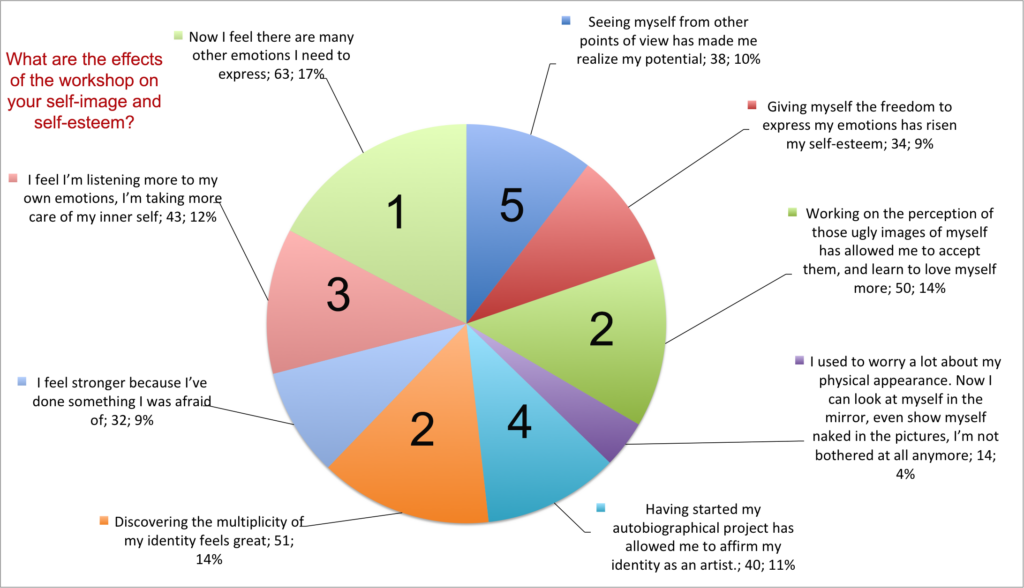
The 2018-19 questionnaires are based on previous feedback. They have been formulated using statements that participants have written in the open-ended feedback gathered from 2007 to 2017. I have used the psychological perspective to formulate all questions and given statements, and to analyse participants’ responses through the following concepts:
- The unconscious creative process
- The broadening of self-perception
- Effectiveness of SPEX in terms of self-esteem/self-awareness/empowerment
- Mirroring in others’ images
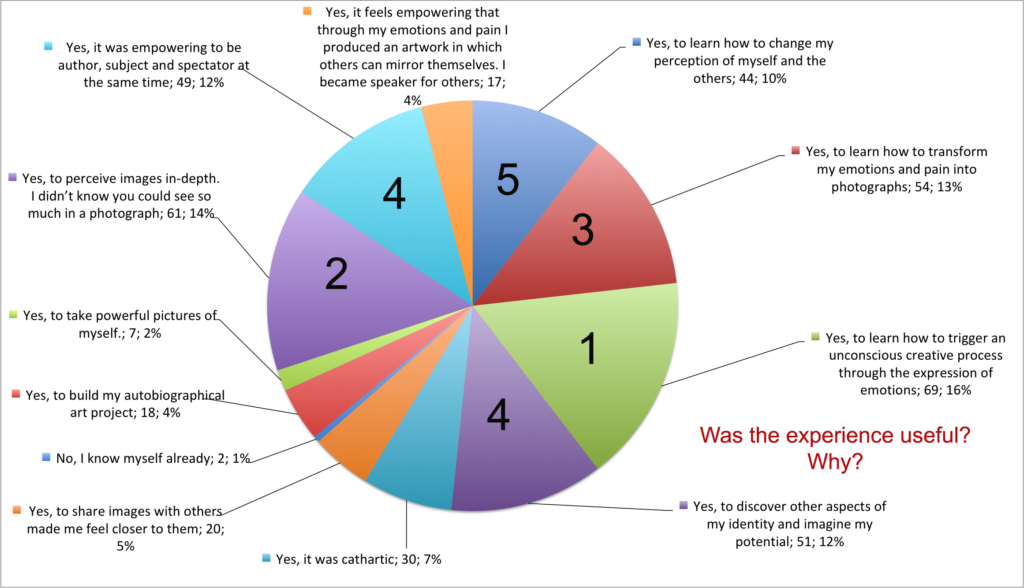
Firstly, data would suggest that SPEX can trigger a partly unconscious creative process through the expression of difficult emotions. Most respondents appreciate having learned to transform their difficult emotions into photographs, as a catalytic and liberating process. Responses support the idea that participants generally do not recognize themselves in the images, and this can provide the necessary detachment to perceive oneself and a feeling of empowerment. The highest effect SPEX generally stimulates is to listen more to emotions that need expression, and this could be the reason why most respondents continue to use the method. An appreciation is evidenced of having learned to explore the multiple and ever-changing perceptions of the images. Lastly, SPEX is generally perceived to foster, both in the individual session with me and with the group, a broadening of self-perception, which can stimulate in some participants an increase of self-esteem. These results also evidenced in the prison data analysis. However, critical open-ended feedback raises issues of emotional safeguarding, even though respondents are not considered as part of vulnerable collectives. An ethical code of practice must be formulated and further tested in future research, including a pre-workshop questionnaire, informing participants about the possible need of professional support during and after the workshops, and defining the boundaries of the liability placed upon the workshop leader.
2. Prison inmates’ feedback analysis
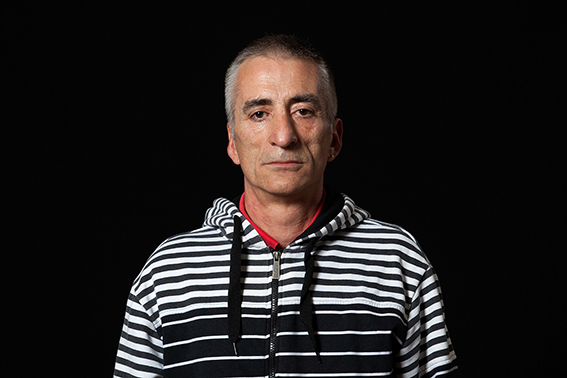
All 148 respondents were serving long-term sentences over one year through fully confined detention; there were no participants on probation. Around 80 of the 148 respondents were in a high security prison or unit.
Gender of respondents: 83 men (56%) and 65 women (44%) = 148
Location of workshops: 18 respondents in Norway (Oslo area) and 130 in Spain (Barcelona area).
Nationalities: Europe: Spanish, Italian, Norwegian. Rest of the world: African, South-American, Asian. Data in my possession does not include specific nationality.
Years of workshops: 2011, 2014, 2015 and 2016.
Length of workshops: 71% of respondents participated to a complete workshop in 5 or more days. For 83% of these, the workshop lasted 15 days over a period of three/four months. The workshop for the remaining 17% happened in three Norwegian prisons during an intensive 5-day week. 29% of respondents participated to an introductory workshop in 2 days.
Following is a brief summary of the results of the analysis, supported by some of the inmates’ statements. The complete analysis will be published in 2021 as part of my new book.
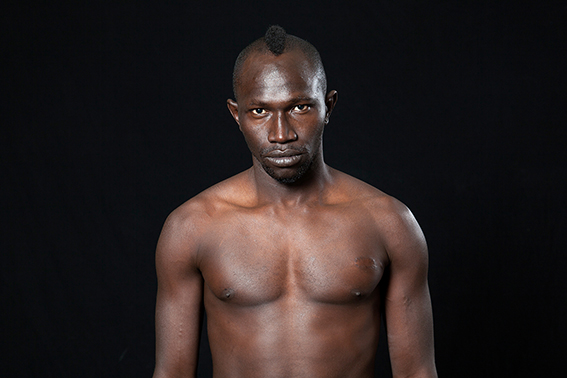
Broadening of self-perception, self-knowledge and self-discovery: 93,5% of respondents asserted that the workshop allowed them to see themselves from a different point of view.
The results of the yes/no responses to the 8th question in the form, “Did you see yourself from a different point of view? Can you explain?” were:
- 80 of 88 respondents said “yes” (91%)
- 4 of 88 said “a little” or “maybe” (4,5%)
- 4 of 88 said “no” (4,5%)
As for the longer responses as sentences:
- 56 of 58 statements responding to that question expressed in different ways that they had seen themselves differently, or from another point of view. (96,5%)
- 2 of 58 expressed that they did not see themselves differently. (3,5%)
These results support the hypotheses that SPEX allows participants to look at themselves from a different point of view, which coheres with Frank Porporino’s views on how to encourage desistance suggestion in prison inmates by “developing programmes that don’t aim to change offenders but rather aim simply to help them explore – to look at their lives through some new lenses” (Porporino, 2010, p.78). Looking at oneself through new lenses can foster the discovery of unknown potential, as one inmate puts it, “I have learned that anything is possible, if you put the energy on things.” In prison, this could mean finding positive aspects in oneself: there are over 30 statements expressing the discovery of their “good sides” or qualities they didn’t know they possessed. Following are some of them:
- I have discovered that I have leadership skills and that I can be loved.
- It was useful to see and feel things I hadn’t even thought about or imagined. I have seen good things in me, that I didn’t see before.
- I loved to see things I didn’t know about myself, to see things I didn’t think I could express. I see I have things inside that I don’t know. The woman in the pictures wasn’t me! I have discovered that I am courageous, I’m a fighter, I’m stronger than I thought; and that I can be someone, I can be useful, I can be a good mother.
- I realised that I’m very strong, that I can deal with the dark side and make it lighter, that I don’t give up.
- I have discovered that I am strong and very vulnerable at the same time. I have seen my inner self and my feelings. I thought I didn’t have any.
Self-knowledge appears in a high number of statements. Self-knowledge is discovering unknown aspects of the self; seeing oneself differently; identify other possibilities and qualities in oneself; and making one’s own inner world visible, that is, as inmates put it, “seeing yourself as you are” “from the outside” but “in a more profound way”. 23 statements explicitly express self-knowledge or discovering other aspects of oneself. Following are some of the most significant:
- I have learned more about myself in certain moments. I know more about my good side. This has helped me to know myself better.
- I have discovered a lot of strength and peacefulness in my pictures, which I didn’t think I had before.
- It was useful to see what I have inside me, to know myself better; to see the anger, the courage and the strength. I see myself as mother courage.
- I had never noticed my own behaviour. I saw my aggressiveness, but also sincerity and the will to change. It was useful to see my inner and outer behaviour and to try and change it. The “bad” part. I feel more peaceful.
- It was useful to know my other self, because the face is the mirror of the soul, it’s a psychological mirror, showing our positive and negative sides. Useful to know myself internally and externally.
- I have discovered my good and bad sides; that I’m not as harsh as I thought.
- I liked to know myself and to think I can improve things. I have discovered that I am strong and very vulnerable at the same time. I have seen my inner self and my feelings. I thought I didn’t have any.
It was useful to know my strengths and my weaknesses (this last was unpleasant to see), and to have more knowledge.
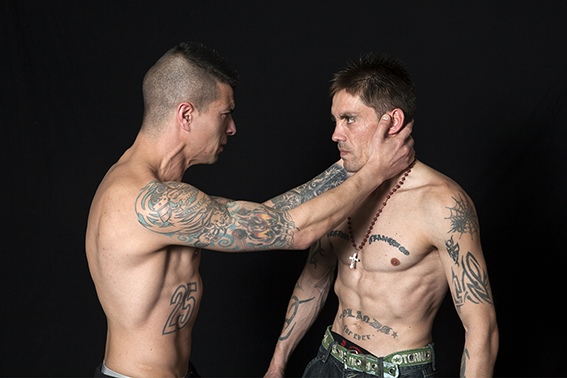
Broadening of perception of others
Responses to the question, “Did you see your fellow interns from a different point of view?” show similar results as responses to the previous question about the broadening of self-perception.
In the yes/no answers:
- 67 of 81 respondents said “yes” (82.7%)
- 8 said “a little” or “some, yes” (9.9%)
- 6 said “no” (7.4%)
As for the longer sentences all respondents expressed in different ways that the workshop allowed them to see their fellow inmates in a different way, and to discover “goodness” and other positive aspects in their peers, as evidenced from the following examples:
- I have discovered that my fellow inmates have more or less the same issues as me. This has allowed me to see them differently.
- In my fellow inmates’ photos I saw goodness, kindness.
- I’ve learned that everyone has a vulnerable side, even though they seem tough in person.
- I loved P.’s pictures, she looked like a warrior! And M.’s strength, and M.C.’s goodness.
- I realized, looking at the photos of others, that they are able to express and show details and gestures that I’d never seen in them.
- I’ve also seen my fellow inmates’ tender and human sides.
- I think I know them better, and I’ve become closer with some. Every one of them is unique, with many positive aspects.
- I have seen emotions in my peers’ photos, in their gazes. They have feelings. We all have feelings of guilt, sadness, anger and remorse.
- I now think that I shouldn’t judge others before knowing them.
A better knowledge/discovery of their peers is evidenced in a high number of statements in theme N.1. Broadening of perception, as in the following examples:
- I have discovered that my fellow inmates have more or less the same issues as me. This has allowed me to see them differently.
- I saw my fellow inmates expressing emotions, so I see them as if they were different people now.
- I’ve learned that everyone has a vulnerable side, even though they seem tough in person.
- In A.’s pictures I was surprised to see the Lioness, because I’ve always seen her very peaceful and intelligent.
- I realized, looking at the photos of others, that they are able to express and show details and gestures that I’d never seen in them.
- I could also better understand those around me. I discovered that they are very much like me. It’s sometimes hard to be yourself, but we all connected and had fun together. I’ve learned a lot about others and myself.
- I saw the others in a more positive way. I have kept inside their emotions and sadness.
Relationships with others
Nineteen inmates have stated that the workshop allowed them to improve their relationships with some of their peers. These respondents had followed a 15-day workshop over four months:
- It was very useful in my relationship to others, because now they see me differently. Before the workshop I was always on my own, I didn’t relate to others. Now I feel better about myself, and I’m not so lonely.
- Yes, my relationship with them is closer. This workshop has helped us get closer to one another. We have talked a lot about it.
- We got more connection between us, beyond what each one of us feels and is. We left past issues behind and we tightened our bond by taking pictures together.
Instead, 10 inmates affirmed that relationships did not get better, as in the following examples:
- My relationships with others are the same. I don’t really want to relate. I didn’t come here to make friends. I am authentic, and others put some “make-up” on themselves.
- My relationship with myself has improved. Not with others, since I go my own way.
However, a longer workshop, at least one year, would be necessary to significantly improve relationships.
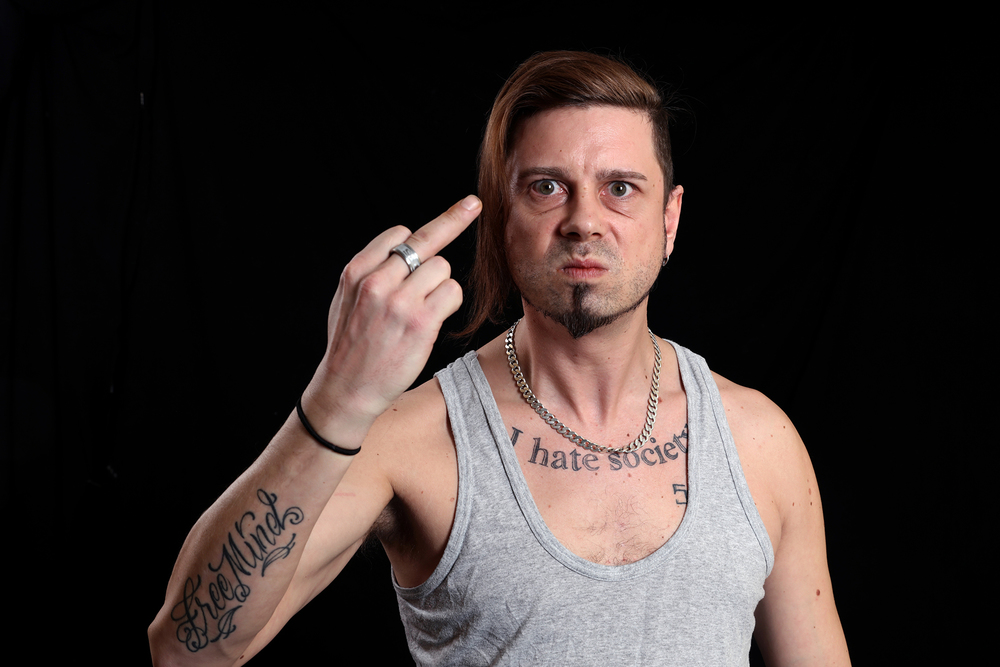
The cathartic expression of emotions
Over 30 statements suggest in different ways the feeling of liberation through the expression of emotions. Following are some significant examples:
- This was a new experience. Before taking the pictures I felt hurt and in pain, but when I finished I felt satisfied and relieved.
- I felt very good with this photo activity, because I could express and let out everything I had inside.
- I could weep. As Arabs we are more coldblooded, we keep things inside.
- It was very positive, because I was able to throw my repressed emotions into the pictures.
- At first it felt strange, but little by little I felt emotions were emerging naturally. I felt it within, and then how it came out.
- It was good to be alone taking pictures, and emotions emerged quickly. I loved that. I expressed my anger and the fear of losing my son, who is ill with cancer.
The unconscious creative process and recognition of oneself in the images.
A high number of statements, as seen in the examples below, suggest that inmates participating to SPEX workshops often discover things in themselves that they had never seen or known. This could support the idea that these things lied in an unconscious dimension, and that the dispositif can bring them to consciousness through the creative process.
- I have seen things I had never seen before in myself.
- I’ve discovered that I have other identities and personalities. I have realised that I am sensitive and sentimental.
- I liked to discover my other faces I didn’t know. They were hidden or it’s hard to express.
- It was useful to see and feel things I never had even thought of or imagined. I have seen I have good things in me that I didn’t see before.
- It’s the first time I see myself. I’ve seen myself in a very different way. I’ve seen so many emotions, fears, hope and insecurities.
- I loved to see things I didn’t know about myself, to see things I didn’t think I could express. I see I have things inside that I don’t know.
- This is innovative, because you can see yourself and see things that you had never noticed, or you had never stopped to observe.
- In this workshop you can learn things about yourself that you cannot see in yourself otherwise.
Other statements suggesting self-discovery and self-awareness can further support that the SPEX creative process stimulates the unconscious to ‘speak’, as one inmate puts it: “I have learned that there is an inner self that wants to come out.”
A high number of statements evidence that most inmates did not recognize themselves in some or all the pictures, as emerged from participants from other contexts in the 2018 questionnaires. This could support the idea that SPEX can bring unconscious material to consciousness, producing an image in which we don’t recognize ourselves, or we’ve never seen ourselves like that. Following are some significant examples:
- It was surprising to see my picture: it didn’t look like me!
- I saw myself in the photos as if they were all different people, not myself. People that think and feel several emotions.
- I didn’t recognize myself; I had never seen myself like that. Also because I never take pictures of myself.
- I recognized myself, but I’ve never seen myself like that, I didn’t know I could have that face and those gestures.
- In some of the pictures it’s me, but in others it’s a totally different person. But in all of them there’s a little of me.
- I didn’t recognize myself at all; it was a strange feeling, because that kind of pictures are the ones I would delete.
- At the beginning I didn’t recognize myself, I didn’t know that my face expressed so much sadness.
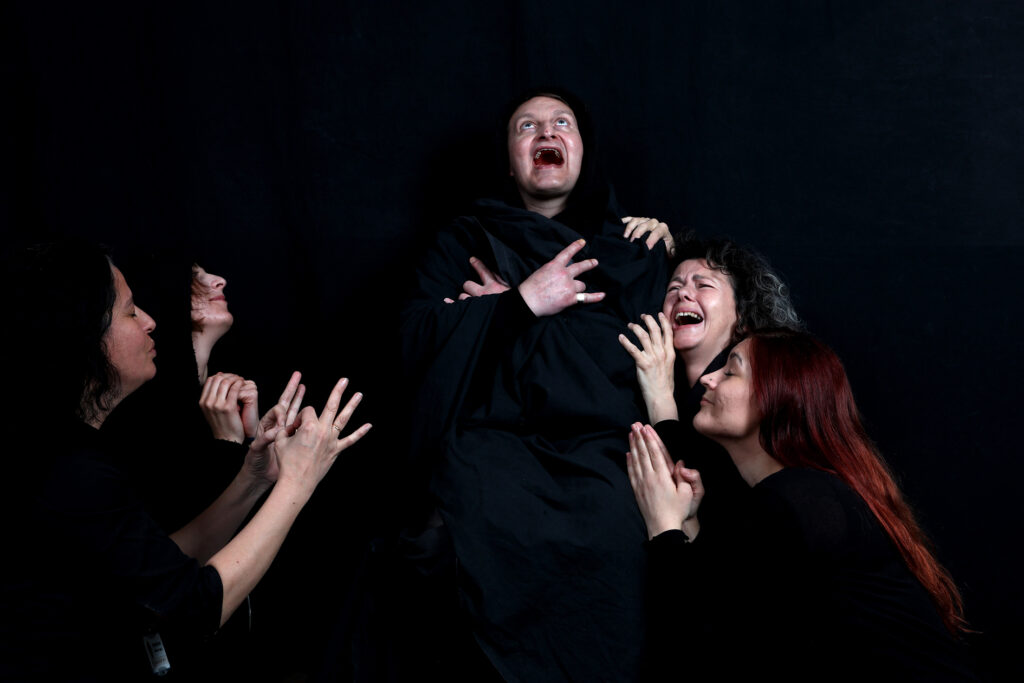
Effects on self-acceptance, self-esteem and wellbeing.
A high number of statements illustrate different ways in which SPEX has provided wellbeing through self-discovery, self-confidence, perception of uniqueness, mastery of emotions, self-esteem, sex appeal, beauty, hope, improvement of life in prison, laughter, the feeling of freedom, and so forth. All of these aspects can help to contrast the strong self-stigma in prison populations. Here are some significant examples:
- I was impressed by the wisdom in my gaze. It gave me hope, and I feel better about myself.
- The workshop helped me build my self-confidence.
- I feel a lot better and I’m more of a master of my own emotions. I look at lot prouder. I have more self-esteem than I used to have.
- I’m not so embarrassed when I see myself now. When I want, I can be sexy. I see myself a little bit younger now in the mirror.
- The experience gave me hope, that I will recover my daughter’s love and trust.
- I think I take more care of myself; I give more value to myself. I listen to my moods and think about them.
- It was useful to improve my life here. To start anew, accepting things.
- This has helped me a lot in my self-esteem. Since I worked with you I feel happier, I’m laughing a lot and people ask me “hey what happened?” I’m proud to be myself. I have shown my pictures to my psychologist.
- I felt beautiful and human, and alive.
- I have discovered that I can cry. I’d never wept, not even with psychologists.
- I liked to do the group work and I realised that in the darkest days you can find rays of light. Although I wasn’t feeling good, this project improved my mood.
Feeling human, alive, and self-confident, suggests that we feel capable of “starting anew”, that in a dark experience such as imprisonment, we can find hope, the “rays of light”. And perhaps feeling human and alive can provide a feeling of temporary freedom, as one inmate puts it: “This workshop allowed me to get out of this hole for some moments, because working with you guys I felt good, freer.”
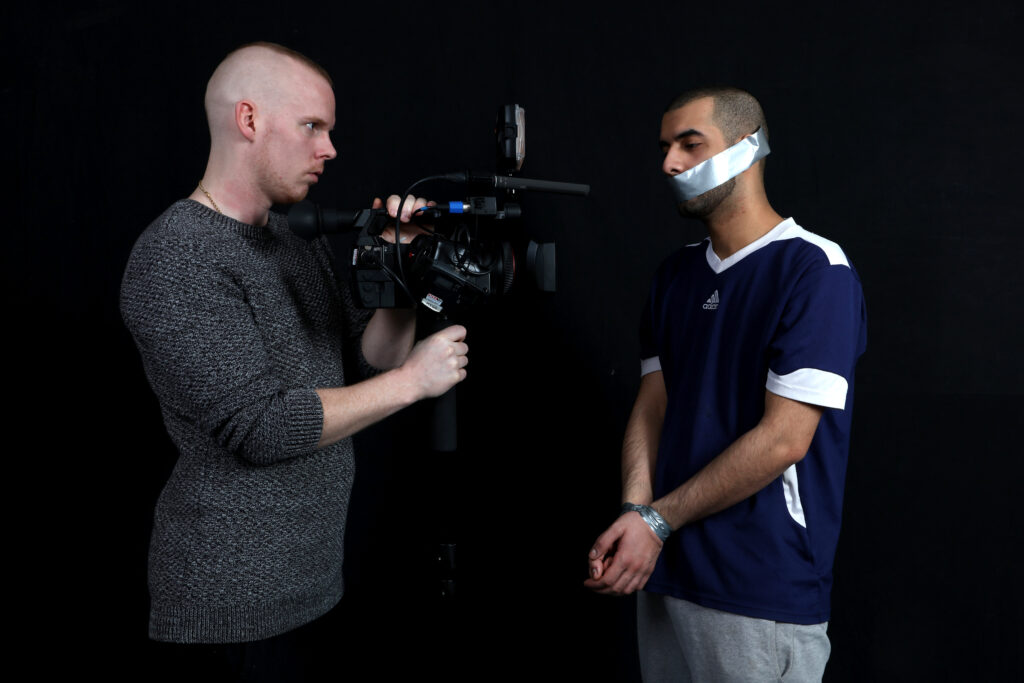
Peer-to-peer approach
My peer-to-peer approach when holding SPEX workshops, by means of disclosing my drug addiction and prostitution and my recovery, is a further way to contrast stigma and self-stigma. As discussed earlier, revealing one’s own shortcomings is what stigmatised individuals tend to conceal (Goffman, 1962), and recovery itself is a deconstruction of labels and stereotypes. Some statements by inmates express the effect that this disclosure had on them:
- This experience touched me very much, because I saw Cristina’s strength while she was telling her story and her pride, despite all her suffering.
- I loved how you presented and how you have dealt with your life since your childhood until today.
- I was impressed about Cristina, she gave us the opportunity to see things in her life. Although I wouldn’t do that, I find fantastic that she did.
- I was great to meet Cristina and know her story, that she has overcome terrible things.
Sharing with inmates my own “terrible things”, narrate my recovery and analyse with them my own and my assistants’ self-portraits before asking them to expose theirs, can fosters trust and an egalitarian relationship. The lack of judgement allows me to treat them as human beings, as emerges from their comments:
- I was impressed at how the facilitators trusted us, when they analysed their own self-portraits with us.
- I was surprised to be treated so well, in an egalitarian way, by people who are outside of prison. I thought they would behave with superiority.
- I was happy to be in contact with people from outside the prison, and treated as a person. It was good to know that people from outside can see us.
- It’s been a relief to be able to talk without being judged. Here we are afraid to talk.
- I liked how the workshop was organized, and how photographers treated us.
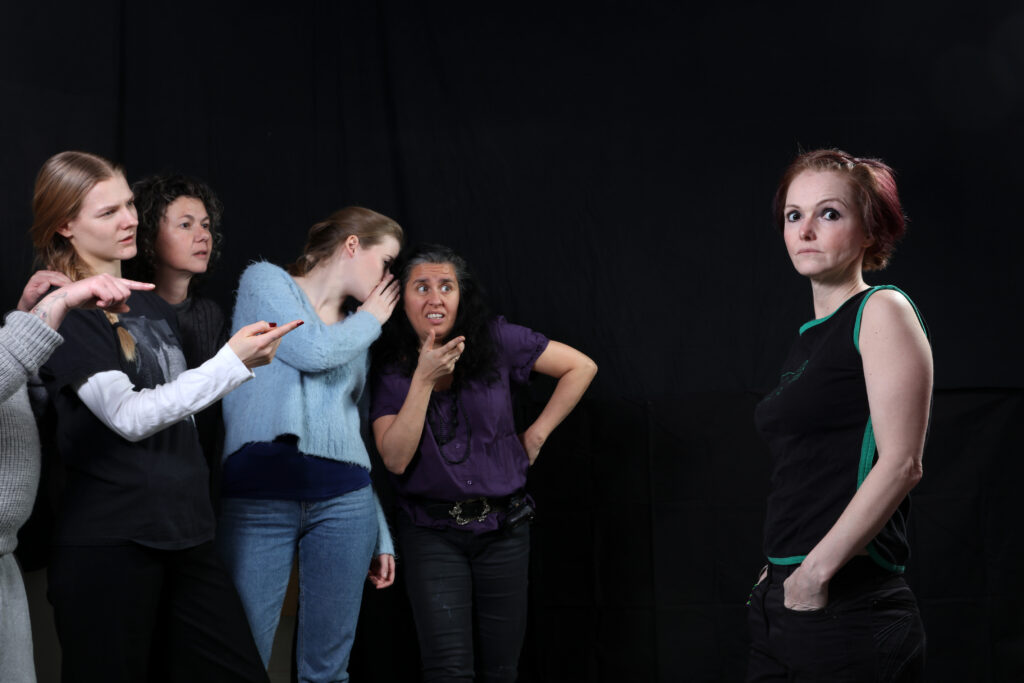
Discovery of the power of SPEX, the self-portrait and photographic medium
A different kind of knowledge is the one referred to the power of photographs to express so much of oneself. This discovery has been almost unanimous, with over 60 statements expressing wonder about how much one can see in a photograph of a face: “intimacy, secrets, feelings, and you can invent stories”. A high number of these, comment on the discovery that the two sides of the face can express very different emotions and attitudes. Another high number asserts that the experience was something new that they had never done before and that they will look at pictures in a different way. “I never imagined you could use the camera this way,” says an inmate. Following are significant examples:
- Before the workshop I looked at pictures, now I study them. I now see both sides of the face and I’m impressed. Looking at the gaze is like looking at your soul, your true inner self. It was very surprising because every emotion and gaze in a picture can express so much.
- It was good to be able to see the pictures in-depth. I have discovered emotions and things that I didn’t perceive before. I was good to discover this technique, and that you can work psychologically on people’s profile through the pictures.
- It was surprising to see what each side of the face can express or what you can perceive in it.
- I was surprised to see that we have many emotions at the same time.
- Looking deeply at photos I see things that I didn’t see before. It’s surprising that photography can be used psychologically to study people. I’m glad to have discovered this technique.
- Since the workshop, I look at the two sides of the face in all portraits I see, even with people I’m talking to, I have surprised myself looking at the two sides of their faces to see what they say to me.
- It was useful to discover that a photograph expresses much more than we usually think, and that people have different perceptions of the same image.
- I liked to recognize emotions in faces, to analyse and discuss together about pictures that we don’t like, but that speak a lot. It gave me good feelings.
- The experience was surprising. I would have never thought of looking at myself and analysing myself in photos this way.
- It’s useful, because you never see your face like that in the mirror. You don’t see your emotions, but in the pictures you see them so well.
- This workshop taught me things that I have never seen in my life. For example looking at both sides of the face, there is a lot of meaning. The pain, the fear, the fury, the anger, the sadness, and a lot more.
- Photographs show us the inner and outer lives of women in prison. The pain, love, the future, our values and our strengths, intelligence and personal intimacy.
